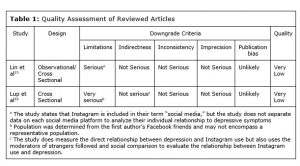Frequency of Instagram Use and the Presence of Depressive Symptoms in Young Adults
Abstract
Background: Depression is one of the most common mental health conditions among patients seen in primary care. It is estimated that without routine screening methods, only 50 percent of patients with depression are identified in clinic. Depression screening improves diagnosis rates, but clinical outcomes are only improved if screening is included in patient-provider encounters. If depression can be detected, it can usually be successfully treated. As the number of social media platforms, like Instagram, and the number of their users grow rapidly, finding a correlation between frequency of use and depressive symptoms in young adults would call for an imperative change in screening methods for depression.
Methods: An exhaustive literature search using MEDLINE-PubMed, CINAHL, and Web of Science was performed using the search terms “depression,” “social media,” and “young adult.” The articles were then searched for specific mention of “Instagram” and those that did not include Instagram specifically in the study were excluded. The “similar articles” search option on MEDLINE-PubMed and references within articles that met exclusion criteria were searched as well. The resulting studies that met criteria were then appraised and assessed for quality with GRADE.
Results: Two studies that met inclusion and exclusion criteria were included in the systematic review. One cross-sectional study showed that social media use, including Instagram, was significantly associated with increased depressive symptoms. Furthermore, participants in the highest quartile of total time per day spent on social media had significantly greater odds of having depressive symptoms. The second cross-sectional study revealed that for participants who followed high amounts of strangers, a statistically significant relationship was found between increased frequency of Instagram use and increased depressive symptoms.
Conclusion: Presence of depressive symptoms and Instagram use in young adults correlate. The evidence points to a relationship between an increased frequency of Instagram use and the presence of depressive symptoms. Providers should continue screening patients for depression following the current guidelines but should remain aware of the relationship between frequency of Instagram use and depressive symptoms. If risk factors in patients’ social media habits are present, providers should consider administering depression screening for further investigation of possible depressive symptoms.
Keywords: Instagram, depression, young adults, social media
(Click on image to enlarge.)
REVIEWED STUDIES:
Lin LY, Sidani JE, Shensa A, et al. Association between Social Media use and Depression among U.S. Young Adults. Depress Anxiety. 2016;33:323-331.
Lup K, Trub L, Rosenthal L. Instagram #instasad?: exploring associations among instagram use, depressive symptoms, negative social comparison, and strangers followed. Cyberpsychol Behav Soc Netw. 2015;18:247-252.
AUTHORS: Alissa Smouse & Steven Hernandez is currently completing their second year in the School of PA Studies at Pacific University, Oregon. They will graduate with an MS degree in August 2017.


